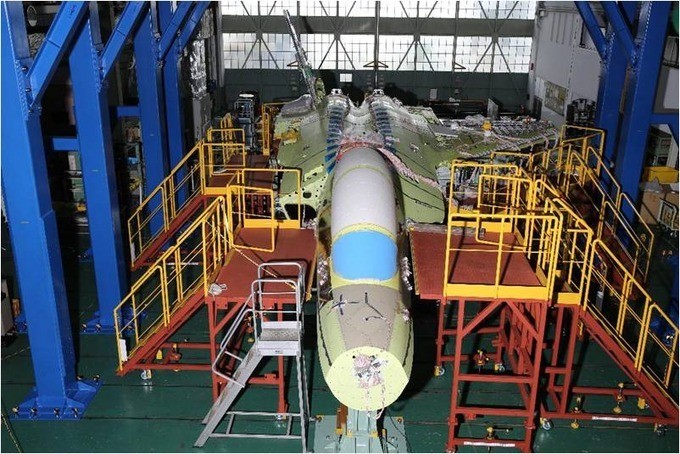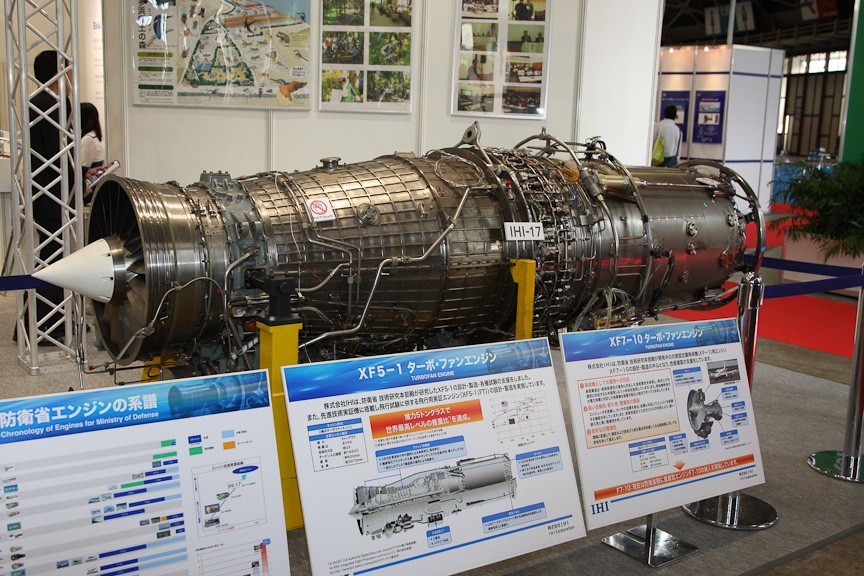you guys take much time to insult each other, while it wastes time.
I myself believe in Japanese, they say less do more.
With strong base of advanced technology and manufacturing ability, Japanese would reach the result without problem.
They even could get the real F35 soon.
China has more limits, so they will be slow, even putting huge amount into the project.
I don't bet on J20 but J31 ... J20 is too "big" for China to manage
In Japanese custom, it is looked down to boast loudly, and to talk very loudly. Far more honorable to talk only when necessary. A samurai does not unsheathe his katana to show it off, he only unsheathes it to cut down an enemy.
------------------------------------------------------------------------------------------------------
@
cnleio , @
Indos , @
KAL-EL , @
atatwolf , @
gambit , @
madokafc
Sometime around 2030, if U.S. Air Force plans come to pass, a fighter that leaps ahead of
Lockheed Martin F-22 and
F-35 technology will enter U.S. service. At about the same time, if Japan's plans come to pass, a similarly advanced fighter will enter service on that side of the Pacific.
It might be the same fighter. Merging Japan's 2030s requirement into evolving U.S. plans for post-F-35 fighters seems to make great industrial sense. Japan plans to begin developing a homegrown fighter within five years, with the aim of beginning production under the designation F-3 around 2027. The defense ministry wants to lay the groundwork to go its own way by investing in stealth technology and building its own powerful fighter engine.
IHI Corp. is to develop a technology-demonstrator engine of 15 metric tons (33,000 lb.) thrust, according to an official document seen by Aviation Week.
Mitsubishi Heavy Industries is already building a small airframe technology demonstrator, the
ATD-X Shinshin, which the ministry expects to test in the fiscal year beginning April 1, 2014. Mitsubishi Heavy is also very likely to build the F-3, which Japanese officials expect will carry a pilot.
Full-scale development would begin in 2016 or 2017 and the first prototype would fly in 2024-25, according to the ministry's plans. Series production is to begin in 2027 and the type would begin replacing Mitsubishi Heavy Industries F-2 strike fighters in the first half of the 2030s. In the second half of that decade it would begin replacing
Boeing F-15Js. The F-15s are older but are likely to remain the mainstay of Japan's air-defense squadrons, with suitable upgrades (see following article).
The exact status of the ministry's plans is unclear, but they probably represent what it hopes to achieve, with some expectation of obtaining approval. It projects production of about 200 F-3s, which would follow the
Lockheed Martin F-35 Lightning into Japanese service. Japan has decided to buy 42 F-35s and may build parts of them. The U.S. Navy and U.S. Air Force tentatively plan to begin fielding new fighters in 2030-35, the former sometimes using the name F/A-XX and the latter referring to its proposed F-X.
Two years ago, the ministry disclosed a research effort for what it called the i3 Fighter, intended to assemble a suite of advanced technologies for a future combat aircraft—or, some suspect, to be offered to the U.S. as a Japanese contribution to the next U.S. fighter. The ministry's Technical and Research Development Institute is leading the i3 Fighter work.
The ministry's plans are evidently firming up, and broadly match a road map for fighter development set out by Japanese industry in 2010. The industry proposal, though, included production of an imported aircraft—now determined to be the F-35—until 2028. While production of the confirmed batch of F-35s, which will replace F-4EJ Kai Phantoms, could not feasibly be stretched until 2028, it is possible that some F-15s could be replaced earlier by additional F-35s before F-3s replace the rest.
The power of the IHI demonstrator engine is surprising. It would generate 50% more thrust than the
General Electric F414, two of which power the
Boeing F/A-18E/F Super Hornet. The Super Hornet's thrust is not notably high for its empty mass, 14.6 tons (32,100 lb.), but in a twin-engine installation the output of the IHI demonstrator would be abundant for a larger, budget-straining aircraft. It does seem that Japan is looking for a twin aircraft: In a single installation, the engine would be adequate for only a modestly sized fighter, hardly suitable as an F-15 replacement.
Japan has discussed plans for such an engine for some time, but the specific thrust and intention to build a full-scale demonstrator have not been disclosed. Japanese industry revealed a drawing of the engine last year, showing that it would follow the general configuration of the Pratt & Whitney
F119 and have a sophisticated arrangement of inlet vanes designed to disrupt radar reflections (AW&ST Feb. 14, 2011, p. 33). In its budget request for the fiscal year beginning April 1, 2013, the ministry has published drawings of three of the engine's modules: fan, high-pressure section and the low-pressure turbine.
The key goal of the engine program is to build an unusually slim turbofan. The low frontal area and the modest bypass ratio evident in drawings would both promote the ability to fly supersonically without afterburner. So would the generous thrust, although 33,000 lb. must be the afterburning rating; the maximum dry output is unknown.
Researchers are aiming to achieve the highest possible temperature at the inlet to the high-pressure turbine, the ministry says in its budget request. They can already achieve 1,600C (2,900F) but want to go higher during the study program, while also reducing engine weight, it says. Mitsubishi Heavy said last year it had achieved a 1,600C turbine inlet temperature, the highest ever, for an electricity-generating engine to be installed in a power station.
Previously disclosed elements of the Japanese engine research include single-crystal turbine rotor blades, stator blades made of ceramic matrix composite (a ceramic reinforced with carbon fiber) and an advanced combustor.
The proposed budget for the fighter engine development is ¥17.2 billion ($218 million), of which ¥4.5 billion would be spent in fiscal 2013. Research would run until fiscal 2017. From fiscal 2015, there would be “testing,” which may mean running the demonstrator.
IHI Corp. will build a 33,000-lb.-thrust technology-demonstrator engine for the F-3 program. (Credit: Japanese defeNse Ministry)
A Japanese engine would not be needed if the F-3 program were merged into a U.S. fighter program, as industry executives suspect it will, since the U.S. would certainly supply its own powerplant. But by developing an engine, Japan will retain the freedom to power its own fighter should it not come to an agreement with the U.S. And even if it does, technology from the demonstrator might be useful to the U.S.
Japanese participation in the next U.S. fighter program is now conceivable because Tokyo has relaxed its arms-export restrictions, which in the past have largely prevented its industry from working with foreign partners. The way is not entirely open for cooperation, however, since Japan might be reluctant to supply some countries that the U.S. sees as suitable customers.
Stealth technology is also a feature of the F-3 program, as it has been for the i3 Fighter. That, too, is probably a hedge against failure to cooperate with the U.S., which is unlikely to need much Japanese help in that area when it designs its next fighter.
Other work flagged for the i3 Fighter might be enticingly dangled under the
Pentagon's nose, though. The Technical Research and Development Institute and industry are working on skin sensors, directed-energy weapons and advanced avionics.
Arguing that neighboring countries—meaning China, South Korea and Russia—will have stealth fighters and longer-range missiles in the 2020s, the ministry is asking for ¥1.6 billion in fiscal 2013-16 to study integration of antennas into the skin of an aircraft, thereby helping to control radar reflections. The antennas would be those for electronic support measures, which listen to enemy transmissions, and electronic countermeasures (ECM), which jam and confuse them.
The ministry also wants to push ahead Japanese ECM technology, to preserve national independence in that area that was developed in building a system for the F-15. The ECM work must be part of what the ministry calls an “all-around surveillance and jamming system.” Japan is also looking for “reflection suppression” technology, apparently distinct from stealth shaping and materials. Details are unavailable. Results of this electro-magnetic work are to be assessed in 2019.
From fiscal 2010 the institute ran a ¥2.5 billion study on “internal weapons aerodynamics,” apparently an investigation into releasing bombs and missiles from bays, and now it wants ¥3.8 billion for further work, including a test rig.
Japan Aims To Launch F-3 Development In 2016-17 | AWIN content from Aviation Week


















